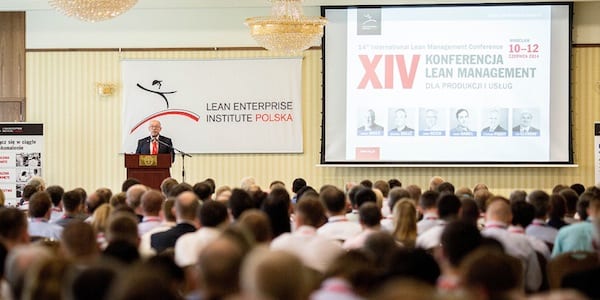
Jim Womack comments on the Volkswagen scandal
WOMACK’S YOKOTEN – The Volkswagen “defeat device” scandal is the latest example of a company that has chosen to focus on growth rather than the customer. What can we learn from this, and what should we do when such a shift takes place?
Words: Jim Womack, Founder and Senior Advisor, Lean Enterprise Institute
Photo credit: Pavel L Photo and Video / Shutterstock.com
When Volkswagen announced a few years ago that it would become the world’s largest car company by 2017 (which just happened to be the year that Chairman Ferdinand Piech would be required to retire at age 80), I was pretty certain that the effort would come to a bad end. The company was saying that its new purpose was to become Number One, an objective that no customer – not one – cared about. So I began to say in my talks that Volkswagen, with high velocity growth rather than meeting customer needs as its North Star, would miss the next curve.
What was particularly bizarre about this “Volkswagen First” initiative was that it was replicating the strategy that had just gotten Toyota in trouble. For decades Toyota had believed that if it put customer needs first and if the value creating processes addressing these needs were continually improved, the enterprise would automatically grow and prosper. However, in 1999 Toyota adopted a new strategy called Global 15. It stated that the objective of the firm was to capture 15% of the global motor vehicle market by 2010 (to make Toyota Number One in market share) and that managers should do what it took to get there. This to me was a complete reversal of 60 years of lean thinking. It was now: Toyota First rather than Customer First. (And, as with VW, no customer – not one – cared about this restated purpose.)
As we know this led to trouble when the growth rate required to achieve the goal exceeded Toyota’s ability to create enough lean managers and its inexperienced managers made serious errors in handling the regulatory environment in 2010 just as it became the world’s largest motor vehicle manufacturer. But Toyota does have an ability to learn from its mistakes and Akio Toyoda, the new president, set as his first goal to return the company to its historic philosophy: Customer First by getting back to lean management basics with an expectation that good results will follow. (And they have.)
In Toyota’s case the restatement of company purpose led to too many new managers with poorly developed problem solving skills. In VW’s case the “just do it” tone set by the leadership pursuing Volkswagen First caused engineers, perhaps at a very high level, to “defeat” regulatory requirements by means of trick software with consequences that are still unfolding. (They also defeated their customer’s efforts to do the eco-friendly and energy efficient thing, with more consequences that are still unfolding.) The new purpose also meant focusing on growth instead of effectiveness in using resources to create value for customers so that VW’s profitability during its growth surge was very anemic well before the current crisis.
We can let Volkswagen worry about Volkswagen. But what about the enterprises we work in or advise? What can we do when senior management shifts from customer first to company first?
I’ve actually had this conversation with a number of senior managers over the years and here is what I say:
You should put your customers first for one simple reason: They have the money. The shareholders want their money back, the suppliers want their money right now, and employees always want a raise. And all of the money to meet these demands comes from only one place: the customer.
Putting the customer first cannot mean boxing them into a corner so you are their only plausible supplier or rolling up your industry to get pricing power. (The latter is Sergio Marchionne’s current strategy for exiting Fiat Chrysler by merging it with another big auto maker. Perhaps we should call this stance “Sergio First”?) And it doesn’t mean reducing the compensation of your employees or shifting burdens to your suppliers. Sometimes these expedients are feasible for a short period, but the means to these ends almost always weaken the basic value creating ability of your company in the long term. So try a harder but more durable method instead.
State clearly that your customer comes first and that you will offer a better value proposition than competitors by clearly defining the value desired by the customer and steadily improving every value creating process at a rate faster than your competitors. This will necessarily mean that the value-creating work in your company will be more fulfilling for employees – because they will be engaged in improving it – and that your suppliers will find working with you more fulfilling as well. You will grow, but how much you grow will be determined by the degree to which you put customers first and the speed with which you hone your value creating processes, not by some arbitrary target set by senior management.
Doing this requires hard work every day. But now you will be focusing on something that necessarily improves the work life of your employees and the business prospects of the firms you collaborate with. Best of all managers at every level will now be pursuing a goal they can actually believe in – doing the right thing for customers – and can play with their hearts as well as their minds.
Can we always persuade senior managers to take this path? Of course not. But every catastrophe from “company first” thinking, with VW as the latest striking example, strengthens our case. It’s a long journey but I think we will get there in the end if we steadily advocate a very simple purpose for the companies we work in or advise: Customer First.
This article is also available in Hungarian here.
THE AUTHOR

Management expert James P. Womack, is the founder and senior advisor to the Lean Enterprise Institute. The intellectual basis for the Cambridge, MA-based Institute is described in a series of books and articles co-authored by Jim himself and Daniel Jones over the past 25 years. During the period 1975-1991, he was a full-time research scientist at MIT directing a series of comparative studies of world manufacturing practices. As research director of MIT’s International Motor Vehicle Program, Jim led the research team that coined the term “lean production” to describe Toyota’s business system. He served as LEI’s chairman and CEO from 1997 until 2010 when he was succeeded by John Shook.
Read more


FEATURE - What if it were your staff driving change rather than managers? A focus on improvement at the front line and on people development proved critical to the lean transformation of a Stanford hospital.


INTERVIEW – Rose Keanly discusses the role of lean in a strategic business transformation in the financial services sector and the dos and don’ts of bringing lean to a large organization.


FEATURE – What are the main problems people encounter when running a project? The author ran a survey with 126 people over two years and presents the results of his research in this article.


REVIEW - Roberto Priolo reviews the 14th Lean Management Conference, held earlier this month in Poland. With great presentations and speakers, the event left him with a lot to reflect on.

